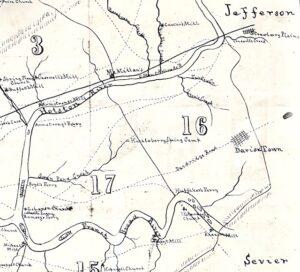When most area people hear “the Fork” today, they’re probably thinking “the Forks” and envisioning areas at the confluence of the rivers, down where the French Broad and Holston converge to create the Tennessee. The Forks of the River Industrial Park, the Forks of the River Wildlife Management Area and the Forks of the River Park (all established since 1960), likely have contributed to the shift in nomenclature.
Historically, however, the singular term “the Fork” has referred throughout earlier decades to the Knox County lands between the French Broad and Holston all the way to the Jefferson and Sevier County lines. As an example, a 1914 article celebrating the determined location of the proposed new high school tells how “Carter’s” is in the center of the broad part of the V-shaped Fork. Detailed property-related papers throughout time, too, demonstrate how the Fork was considered to include more than just the point at the rivers’ confluence.

1914 article
Back when I was teaching a Sunday School class of elderly Mascot community ladies in the 1980s, they asked me where I had grown up. When I told them, they commented with an identifier that was new to me, “Oh, you’re from across the river!” Their observation perplexed me. I had never considered the river to be a geographical boundary of significance, but they had all experienced childhoods without the luxury of bridges across the nearby rivers. For older generations, the Fork was remembered as a separate land mass. See last week’s article How It Began.

Map of 1870s Fork ferries
Today, we think little of traveling from point to point within our county as we drive across where early bridges were constructed at Mascot (1931), Asheville Highway (1931), Boyd’s (1949), John Sevier Highway (1963) or I-40 (1975), but not too many decades ago, you had to be more intentional about getting to the Fork. Prior to the building of Knox County bridges that span the Holston and French Broad Rivers, the Fork was accessible only by boating, fording or ferrying.
According to research by Tony Holmes, published in the Tennessee Anthropologist in 1991, the ferry crossings that served the Fork began by 1791. They included McBee, Armstrong-Ruggles and Boyd’s on the Holston, and the Huffaker and Bowman-McBee-Hodges ferries on the French Broad, as well as the ferries at the point of the Fork, owned across the centuries by various families such as Anderson, Brabson, Cosby, Gilliam, Jack, Ramsey, Rhea, Thurman, Wassum and Wright.
An 1889 article, describing meetings about a proposed railroad leading across the Fork and into Dandridge, told how the project’s promoters had ferried the Holston, and it identified Huckleberry Springs and Thorn Grove as communities within the Fork. It stated how citizens of Knoxville “have not generally had the pleasure, however, of visiting this section of our county, the land between the Holston and French Broad rivers….”
The railroad venture never materialized and, along with the ferries, is just one more bit of history forgotten in the Fork.
Jan Loveday Dickens is an educator, historian, and author of Forgotten in the Fork, a book about the Knox County lands between the French Broad and Holston Rivers, obtainable by emailing ForgottenInTheFork@gmail.com.

